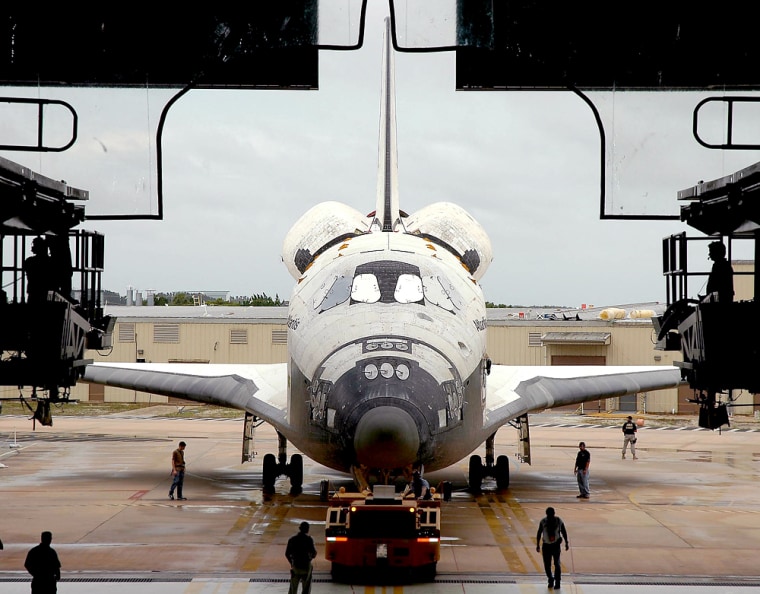HOUSTON — As NASA continues to assess the impact of Hurricane Katrina on the future of the shuttle program, at least one official is warning it could take up to a year before the next flight takes off.
The space agency grounded future shuttle flights after a fuel tank insulation problem was found during Discovery's mission a month ago. The pre-Katrina hope was for a new shuttle flight in March 2006, but after NASA’s Michoud facility in New Orleans was hit during the hurricane, analysts expected that mission to slip into May. That now may turn out to be overly optimistic — and not just because of the hurricane damage.
MSNBC.com has obtained an “extremely preliminary” planning document written by Wayne Hale, NASA’s deputy shuttle program manager, in which he concludes: “Launch dates before the fall of 2006 may not be credible."
Sources point out that this is not a proposed schedule, much less an official "schedule slip" — at least so far. A lot of "worst case" planning is going on, to identify bottlenecks. Once that’s been done, reallocation of resources and allocation of high levels of cleverness can do much to streamline the process, they said.
A NASA spokeswoman said Wednesday that no decision had been made yet on a new launch window and that the agency was still determining the extent of the hurricane damage.
Beyond the highly-visible impacts of damaged facilities and scattered workers, new delays entirely unrelated to the hurricane damage have also come to light. Solutions to the foam shedding problem are going to take a lot more time than space workers had initially hoped.
Shuttle plant workers homeless
Efforts continue to rehouse space workers from the Michoud plant that produced the disposable thirty-ton external fuel tanks used for shuttle launches. An estimated half of them are now homeless, and many have been relocated to temporary lodging near NASA facilities in Houston, Huntsville, Ala., and Cape Canaveral, Fla..
The critical work to diagnose the tank problem that caused unacceptable levels of foam shedding during Discovery’s launch — the same flaw that fatally injured the Columbia in January 2003 and led to the deaths of all seven crewmembers — is being transferred to surviving NASA facilities. These facilities are also assessing how reliably they could perform repairs or rebuilding of existing tanks.
Specialists inside and outside the program hope that a process can be quickly developed and implemented even after the hurricane disruption.
Hale’s memo also gives an overview of the hurricane's impact at other NASA locations: “Rail transportation of [Solid Rocket Motors] normally utilizes the rail terminals in the New Orleans area,” he writes. “KSC [in Florida] is being affected since power generation in Florida is dependent on natural gas from offshore production,” he continues, adding that “conservation of electricity has been mandated and impact to work at KSC is possible.”
Furthermore, Hale writes, “We have not yet assessed the impact to schedule caused by Stennis Space Center [in Mississippi] main engine testing delays.”
Hale's memo says that the Michoud facility, a converted WW2 airplane assembly hangar, “will not be open for business until utility service can be restored”, which will take “a month or more”. One of the stored fuel tanks was damaged from falling roof debris, but the dock facilities appear to be functional.
However, even for workers whose homes were not hit, getting to work will be a challenge since “much of the workforce lives on the north shore [Slidell, etc.] and all bridges to the east and north are severely damaged with no near-term prospects for repair.” In addition, computer specialists still need to get access to Michoud in order to retrieve key data stored only on that facility's computers.
Hale's memo expresses optimism that significant tank work could be performed in Florida. There is a "clean-room" hangar available, and environmentally-controlled tents could be deployed on the floor of the Vertical Assembly Building where launch vehicles are stacked prior to rolling them out to the launch pads.
Surprises from flight data
Of fundamental importance to the development of a credible flight preparation schedule is the effort required to discover exactly WHY so much debris came off Discovery's external fuel tank, particularly from the PAL (Protuberance Air Load) ramp, an area of the tank where the foam insulation needs to be applied by hand. Hale's memo also provided a new assessment of the difficulty of this problem that had nothing to do with Katrina.
The most recent mission, he explained, “had flight instrumentation on the [forward] PAL ramp,” and the results were a “significant data surprise” since “the data from this instrumentation did not correlate with [computer modeling] and wind tunnel testing.” In other words, it’s not just a matter of NASA not knowing what the aerodynamic stresses were going to be — they thought they did know, but what they knew before the flight turned out to be wrong.
Based on this surprise, Hale continues, “the technical community is extremely reluctant to agree” with removing these troublesome PAL ramps (as some engineers have suggested) based purely on computer model validation. “Flows in this area are unsteady,” he explained, “and [computer model] techniques are not well suited to analyzing unsteady flow situations.”
As a result, Hale concludes, removing the ramps "is not considered a serious next-flight option.” And even if the flight data could be obtained, he adds, the timeline his team had developed showed that a “non-PAL ramp tank could be made available in the October 2006 time frame” — it would take three or four months after that date before a launch could occur.
Other repair proposals face similar extensive analysis efforts, but Hale's memo also suggests that none so far show any evidence they could be done by the middle of next year.
